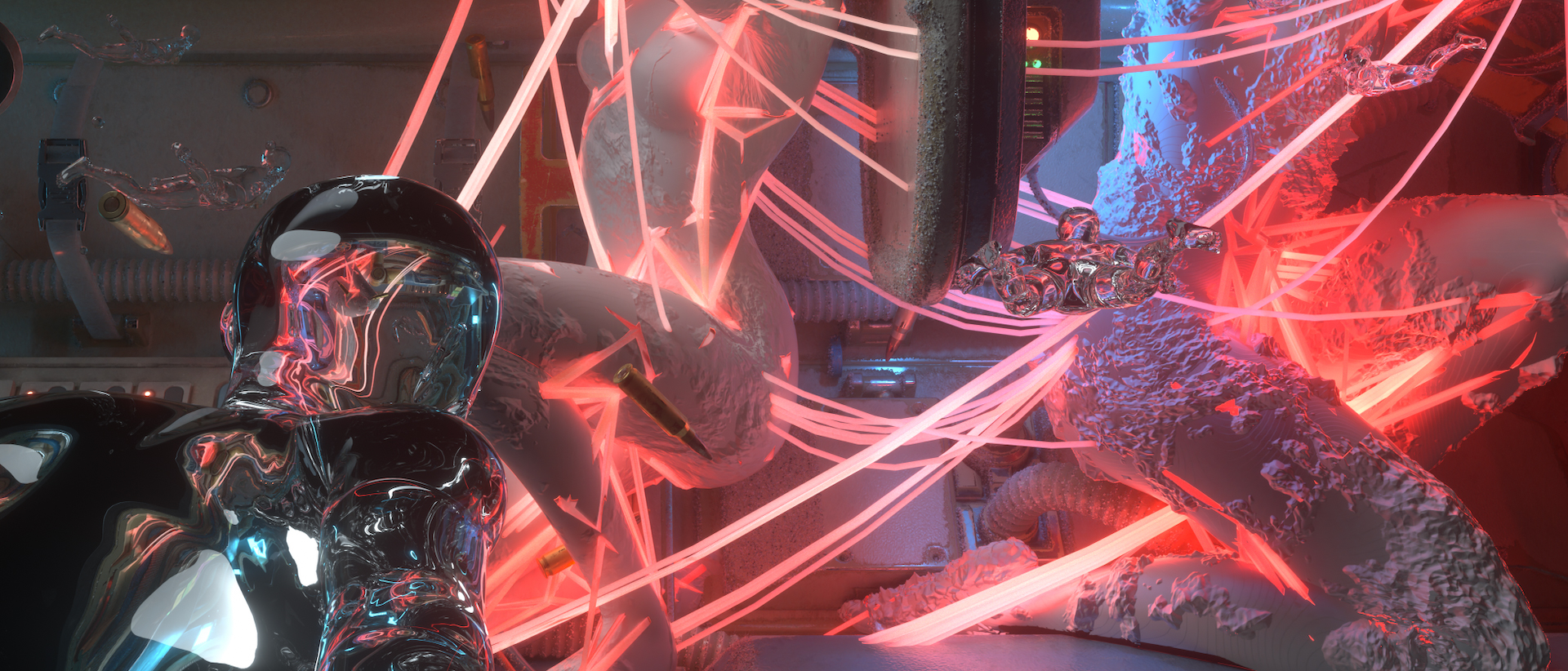Original LEDYan Sound Money 2022-06-10 21:15 https://mp.weixin.qq.com/s/RKAMQgc3sozdz4TgO44bZw
Revisiting experiences.
From the 4 CryptoVoxels halls
Looking back at the Venice Metavoxels Art Exhibition
Written by Guo Cheng
Virtual, digital, and video games are all placed in the category of “Metaverse” today, and it is clear that this perception of pouring old wine into new bottles is lazy and wrong. “The 1st Annual Metaverse Art @ VENICE is a joint initiative of Victoria LU, virtual singer Autumn and artist CryptoZR. It opened in conjunction with the Venice Biennale. Echoing the offline exhibition, Liu Jiaying presented her work in four plots of CryptoVoxels (CV) at the same time. Looking back at the Venice Metavoxels Art Exhibition from the 4 CV galleries may help us outline the shape of the metavoxels.
Founded in May 2018 by New Zealand indie game developer Ben Nolan, CryptoVoxels features NFT-tagged space plots, wearables, and even asset-based properties of usernames, all based on blockchain technology for early web3 virtual space exploration. Technical elements such as decentralisation, distributed storage, and anonymity are also internalised into a cultural attribute building up this meta-universe space.
Liu Jiaying began acquiring land in CV in 2019 and built the “Chijin” art museum. A large Buddha is placed the middle, and the building’s bright colour scheme makes it stand out from the crowd of other buildings. The Voxel Hotel was located directly across the street from Chijin, which was then the most popular plot of CV — the club-styled building was decorated with Meme references, creating a great cultural contrast with Chijin. Liu Jiaying owns several plots of land in CV, and as the CV architectural team became more experienced, she created Topbidder in 2021 and the Point Zéro Art Museum in 2022. For the “1st Annual Metaverse Art Exhibition@Venice”, she combined Chijin, Chijin-vice, Topbidder, and the Point Zéro Art Museum and exhibited the 4 CV buildings as part of the exhibition hall to exhibited her encrypted artworks concurrently with the Venice biennale, which became a representative case for us to discuss Metaverse art.


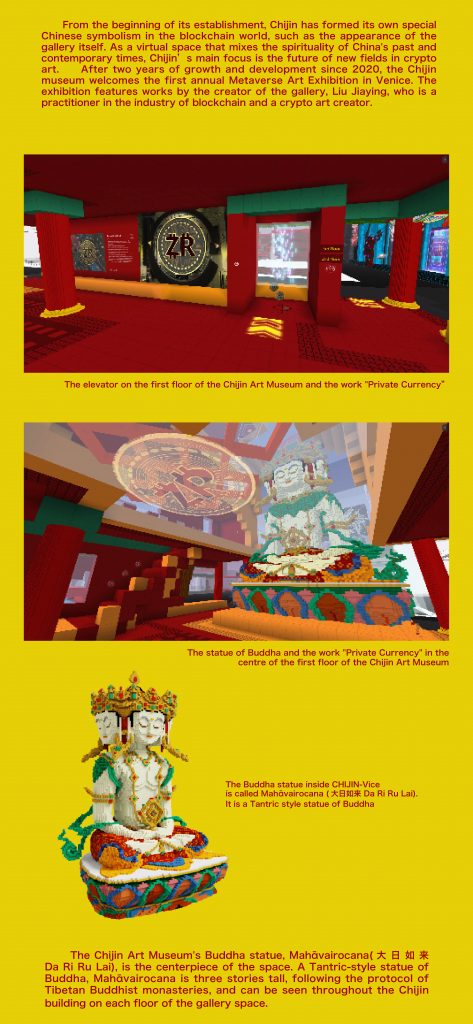

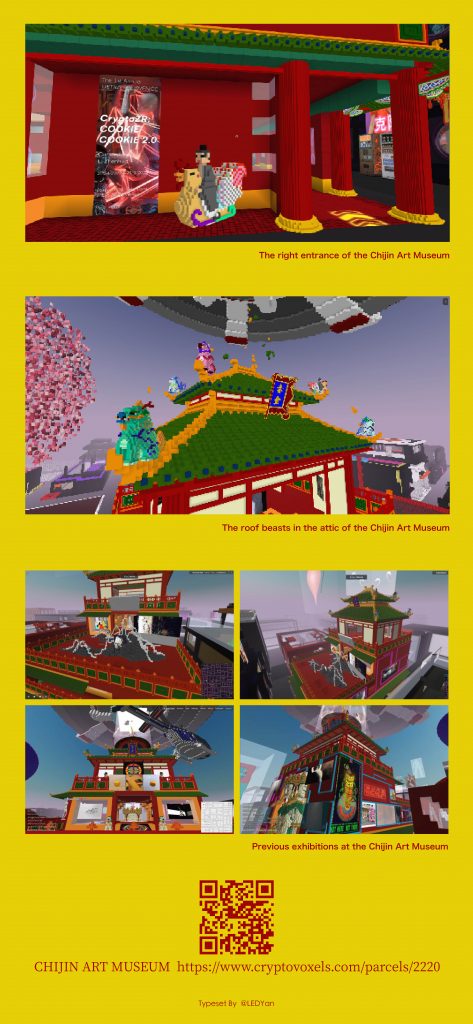
NFT’s Doppelganger
When “non-homogenized passwords” came into public knowledge, the first thing that resonated with community of the art field was the protection of copyright. Security, uniqueness, clarity of circulation, and clear traceability are all attributes that fit the business needs of third-party art institutions, which is why NFT is known publicly from the auction houses. In NFT, in addition to the asset-based properties of the token, the metadata, or images to which NFT points, can be downloaded and saved 1:1, which gives the possibility of displaying the works simultaneous in different spaces.
A piece of Anselm Kiefer’s work can only appear at one site, and the unique materials of lead, hay, and clay on the painting are overflowing with the artist’s aura (as described in Walter Benjamin’s text), and when these materials are photographed into an electronic image, the information about the physical object is made obsolete except for the archival retention, so we need text to support the description of the image in an attempt to recreate a sense of the original artwork to the viewer. NFT works (specifically in the form of NFT+image) are the same as digital art, whether it is an image or a video, the original work = a reproduction, and it becomes possible to show it in different places and different scenes. Liu Jiaying’s works are exhibited simultaneously in Venice and in five locations located in CV, and the different scenes also provide a diverse space for the works to be experienced.
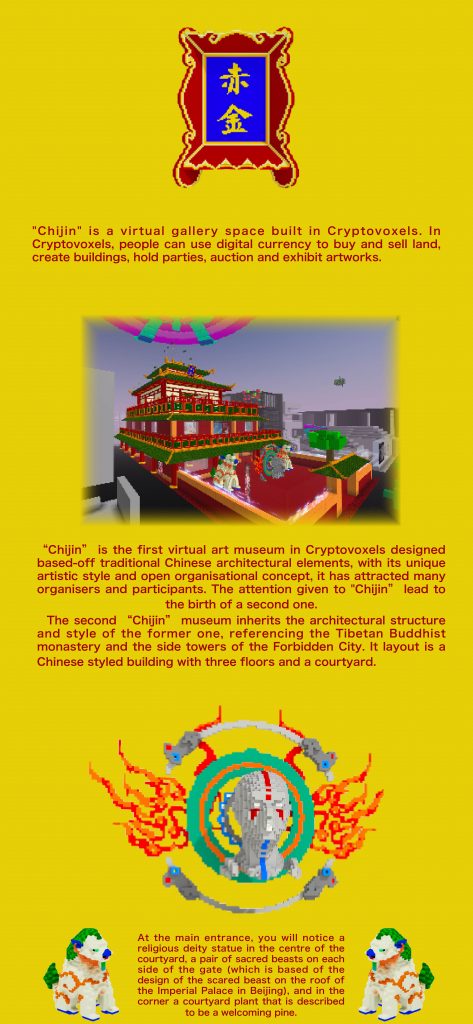
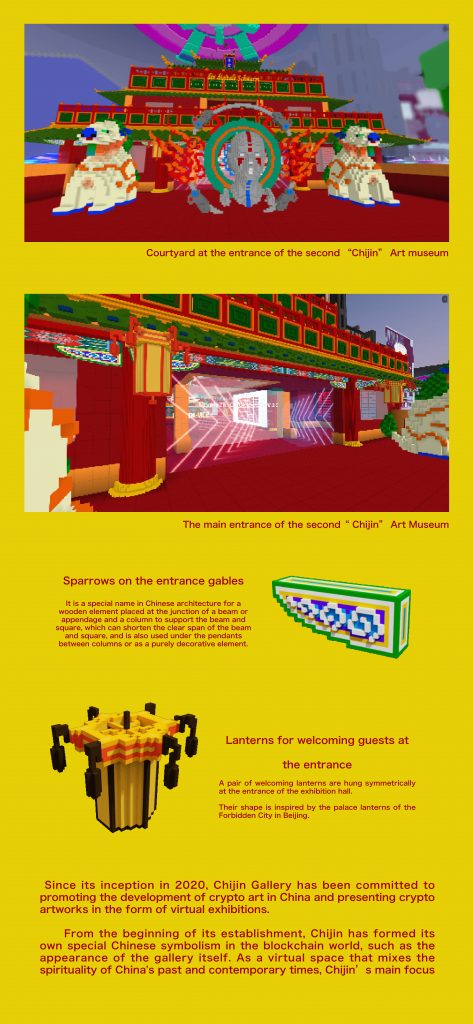
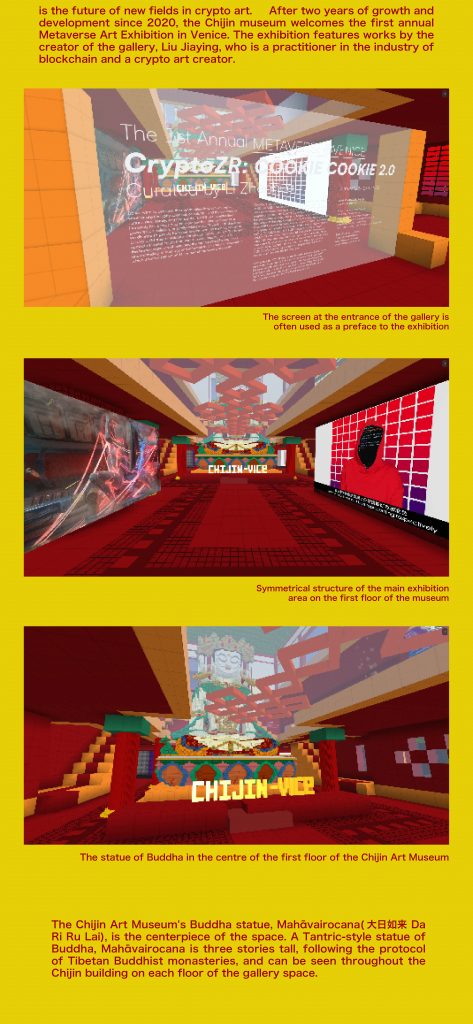
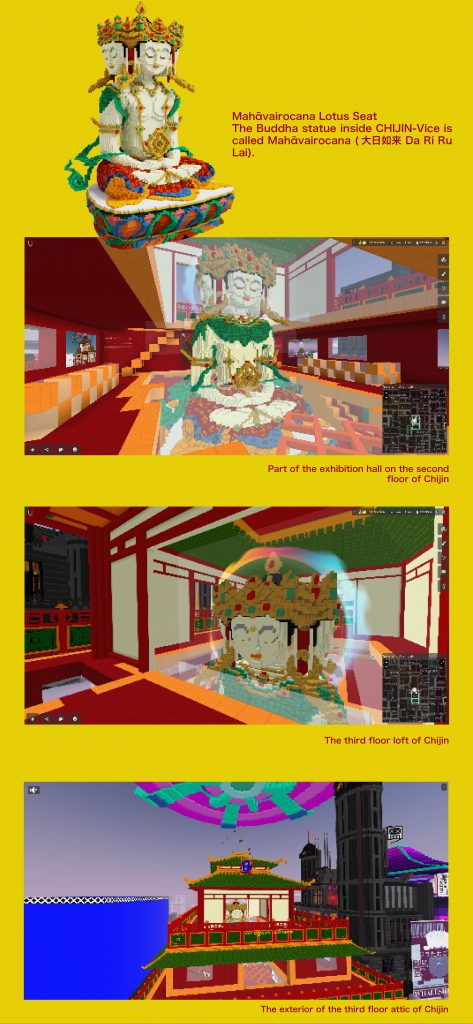
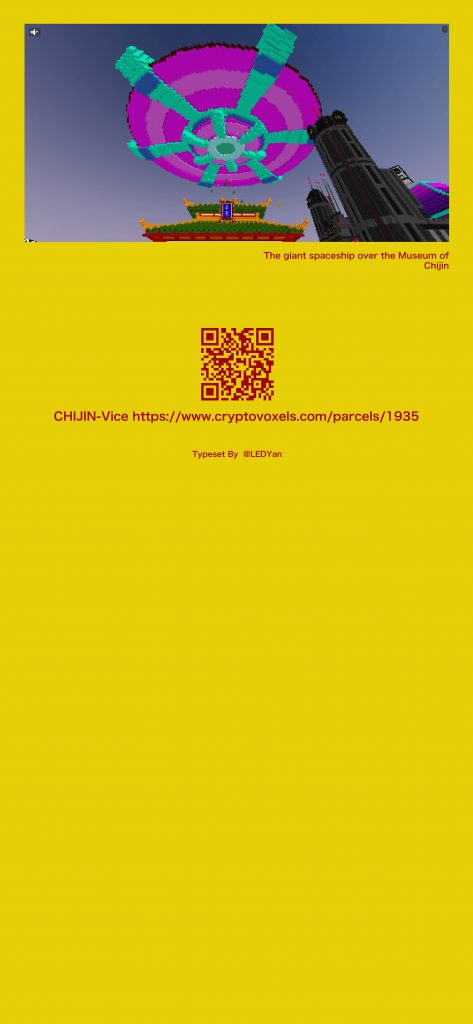
Remote site and time-lapse network
When we talk about “site-specific“, the preconceived notion is of the arrival of the physical body. The presentation of classical art considers the site as the only way to present the work in its entirety — the feeling of the space, the texture of the work, the interaction with the audience, and the curation of the viewing path are all factors that build the meaning of the work. The virtual space of the Metaverse reconfigures almost all of these relationships: the open page replaces physical arrival, screen-based perception depends on the display device, and cell phone screens, computer monitors, and wall LEDs are very different viewing sensations, and the immersive experience is closer to the vision of the Metaverse if the virtual space is accessed with VR devices. Liu Jiaying initiated the construction of virtual buildings such as “Chijin”, “Topbidder” and “Point Zéro Art Museum” in CV, which became a continuation of the live experience in the 3D space located in Venice. In the midst of many meta-universe explorations
Among the many Metaverse explorations, time is a dimension that cannot be challenged. The teleportation of the digital avatar may seem free, but it is impossible to see (or experience) the entire exhibition beyond a piece-by-piece view/appreciation. Though teleportation within the Metaverse might offer the possibility of a non-linear experience. With teleportation linking the four CV spaces to each other, the avatar moves unobstructed between these teleportation points, and the same artwork starts to act as a thread of information linking the experiences in different environments, as if entering a time trap in a dream.
The experience of lagging is alien to web2 users, and large companies optimise game experience to run smoothly. In a decentralised and collaborative mechanism, the efficiency of software development always lags behind the needs of users. For Chinese users, the barrier of network firewall is an obstruction that affects their experiences. Is attention a scarce resource for web3 and is the meta-universe of delayed jams a factor that is holding it back? Between decentralisation and efficiency, the crypto community will give its own answer.
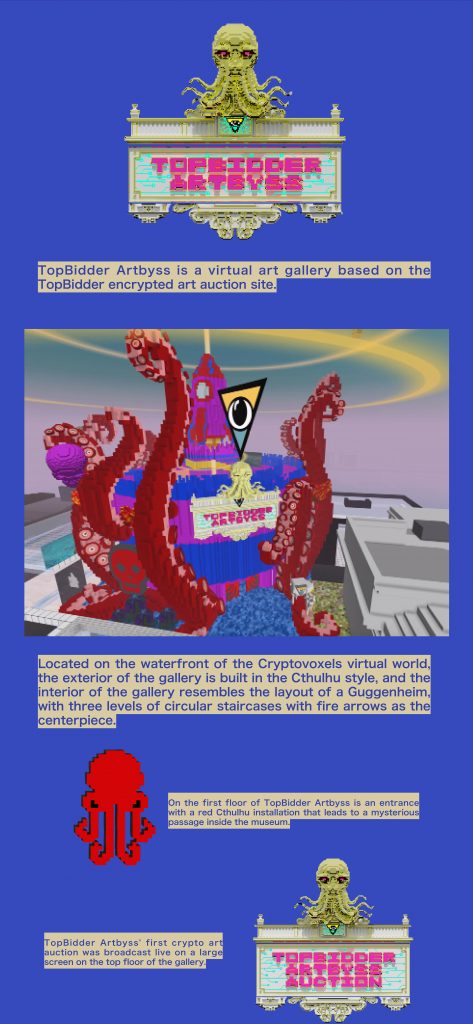
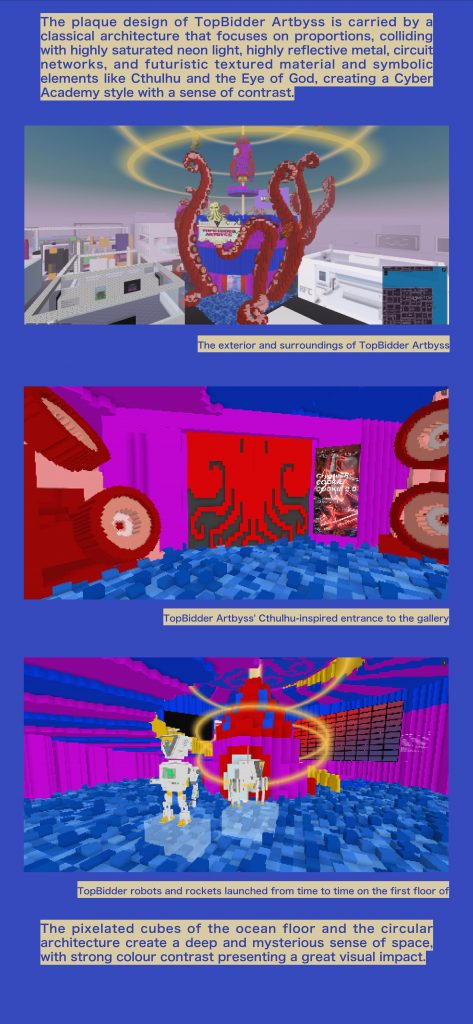

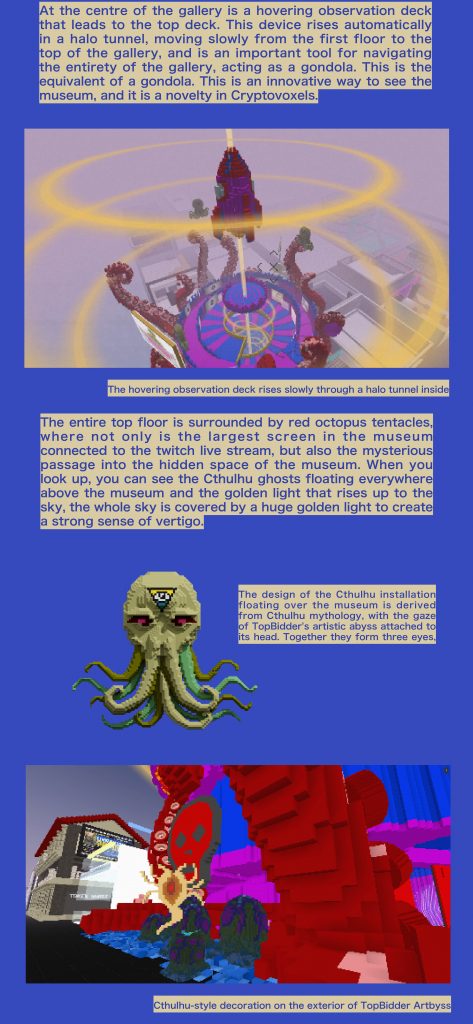
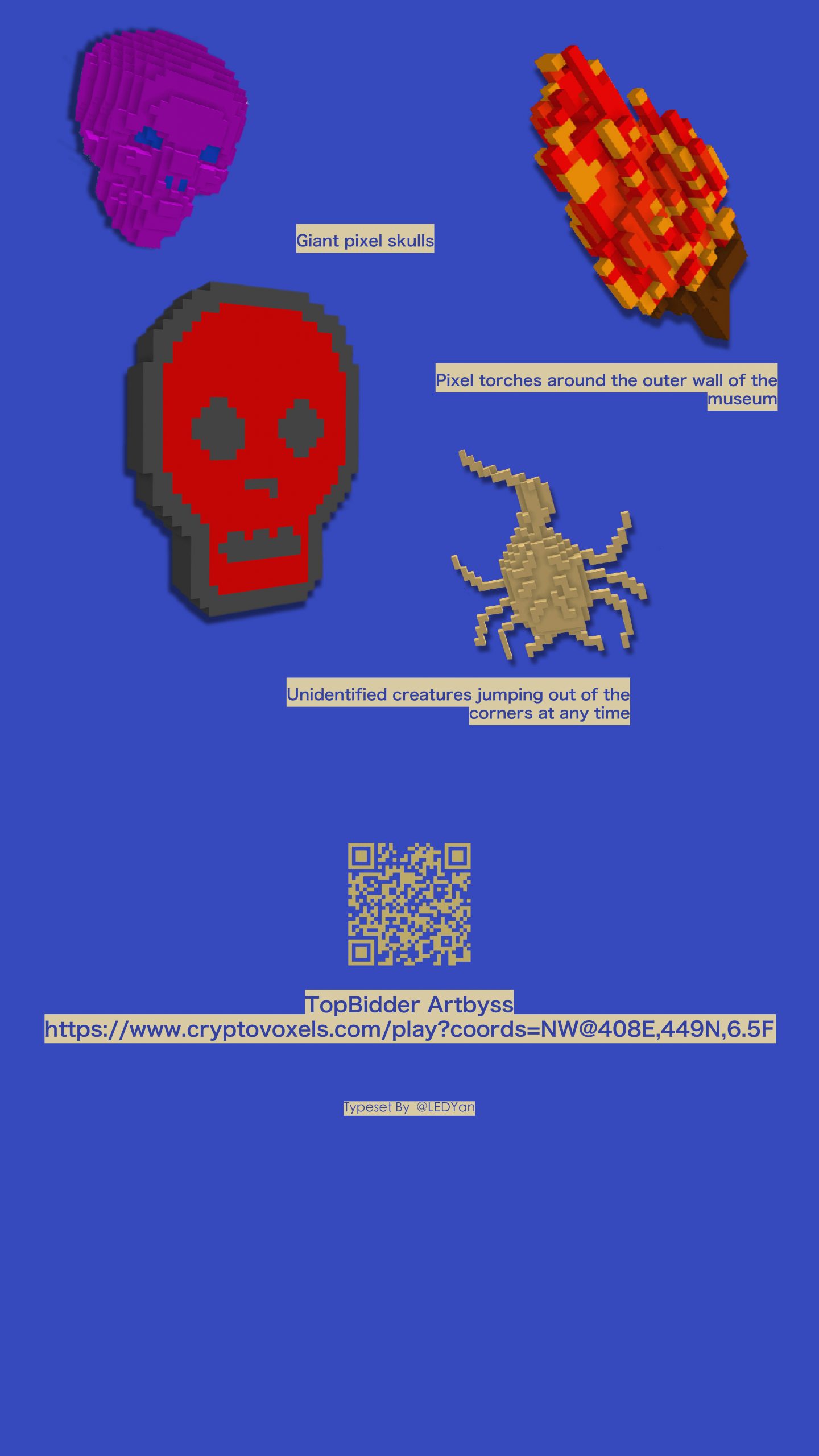
Looking at Faith from an eye-level
Among the four CV spaces, two are Chinese temples named “Chijin”(Red Gold), the Point Zéro Art Museum is a Gothic space inspired by the Notre Dame in Paris, and Topbidder is a circular exhibition hall in the shape of a Cthulhu giant octopus. Drawing on the architecture of real temples and churches, an avatar is designed in the centre of the space of both Chijin and the Point Zéro Art Musuem. Because avatars in CV can fly, it gives the viewer a different viewing perspectives and this changes the way sculptures in the world are built — the proportions of the sculpture are now “proportionate”.
In traditional spaces, people view statues or sculpture from a bottom-up perspective because of the space limitations of the temple. This detail of production is not a lack of skill on the part of the craftsman, but a deliberate visual compensation. The experience of flying allows us to re-examine the visual changes in the meta-universe, and to fly up to see the details that we “can’t see” from above. There is no need to adjust the scale of distortion to meet the visual error of viewing from a bottom-up perspective. The image of “God” become similar to that of “man”. But as early as 2019, in the “Chijin” space, the Chinese Buddha still has the “big head” quality of real spaces, a cultural cue, a visual relic before the creators became familiar with the flying experience.
If you wish, you can also fly as high as you like to look down on this land of creativity. It is not difficult to notice in the CV space that most of the buildings are topped with a 3D logo marking the qualities of the building itself. Mercedes-Benz Cars has installed rotating tridents on the tops of its corporate buildings around the world, allowing people to see the strength of this multinational company from a distance. And for the creators of CV, the rooftop installation is not just a display of the brand, it is more like a three-dimensional work, an installation that becomes part of the whole building. On top of the tower in the shape of Notre Dame de Paris in the Point Zéro Art Museum, hangs a red and a blue suspended cubes which are derivative creations of Liu Jiaying’s work “Red and Blue”, where religious architecture and great power jockeying are the centre of cultural tension in this space.
For the author, this space, which is called “architecture”, can be considered as an independent aesthetic object if the need to display works inside is removed. The open tentacles have no relationship to the architectural space, and the complex appearance does not take into account the architectural gravity or space; it is not fundamentally different from an installation. A pillar of light shoots from the ground through the centre of the building into the sky. If you want, you can press F to take off and follow the pillar of light through the top of the building into the air, passing among the small floating octopuses. For the same form, the pre-determination of functionality in the spatial relationship between the building (accessible), the sculpture (solid), and the derivative (small) multi-layers is an important factor that influences the thinking of Metaverse architecture. While real-world design comes from human physical limitations, when code supports avatar flight, “looking up” becomes a poetic expression, and the religious sublime is redefined.
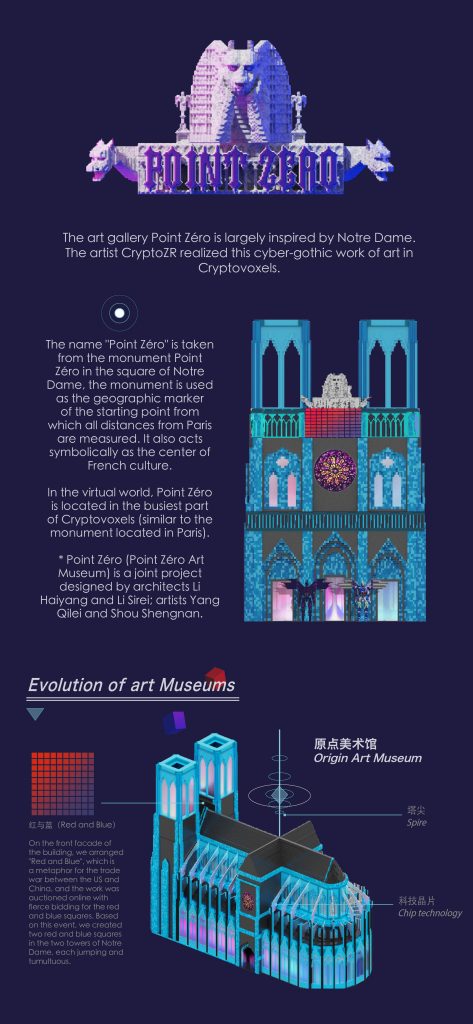
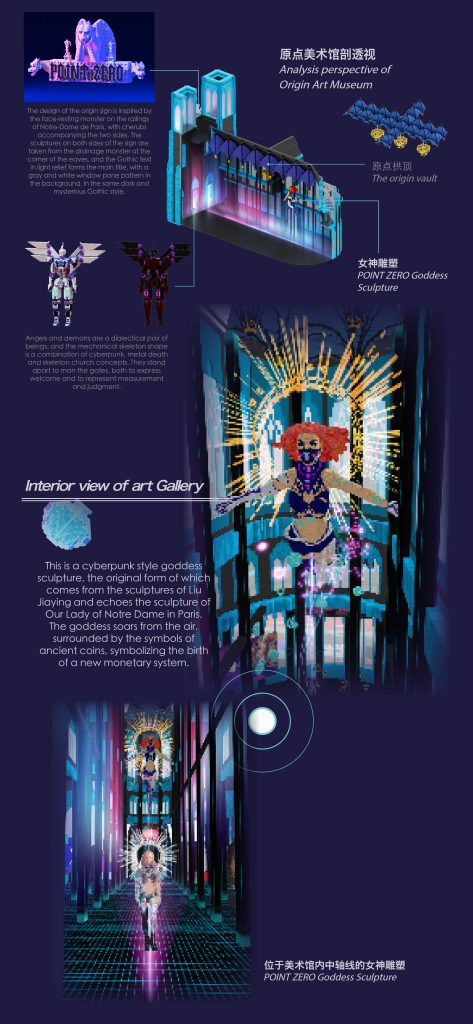
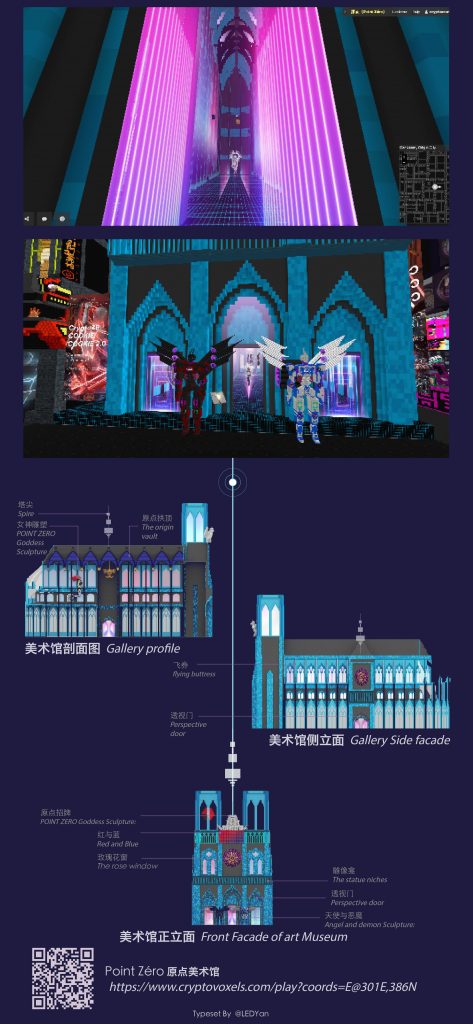
Loitering avatar
Liu Jiaying posted a picture message in her Wechat moments, “Standing in Chijin while looking at Point Zéro Art Museum”, where two different styles of east and west are placed facing each other across the street. In the context of the meta-universe, talking about cultural “collision” seems to be out of place. In 2019, when the first Chijin Art Museum was completed, across it was The Voxel Hotel, a nightclub-styled space filled with images of Internet memes, Japanese characters paired with European and American faces, the same way Van Gogh copied Ukiyo-e in oil, it signifies a new form of globalisation.
The French philosopher Lyotard described in “The Postmodern Condition” (1979) a situation of globalisation in which one eats breakfast in Paris, goes shopping in Hong Kong, eats Japanese food in Tokyo at noon, and sprays French perfume. …… It took a century from Verne’s science fiction novel “Around the World in Eighty Days” in the 19th century to the day of globalisation described by Lyotard. Another 50 years have passed since the “post-modern condition”. Globalisation in the Metaverse is internalised, with cultural fusion and mashups taking place in the same building, in the middle of Point Zéro Art Museum which is in the shape of Notre Dame there is an 2D image of an Asian god, and across the street from the Museum is a cybernetic hotel.
Meta-universe users don’t know what culture shock is, because they come from an Internet age where culture is stirred evenly in the juicer. It is worth noting that, like Benjamin’s wanderers in Paris, the real people behind the avatar screens are the “techno-Bourgeois” who profit from the digital currency economy, spend their leisure and money in the Metaverse, and find the aesthetics of it in their wanderings – the very place that gave birth to crypto. — This is where crypto culture is nurtured.
-End-
Learn more ☟☟
– Exhibition@Voxels:
Point Zéro
https://www.cryptovoxels.com/play?coords=E@301E,386N
TopBidder Artbyss
https://www.cryptovoxels.com/play?coords=NW@408E,449N,6.5F
CHIJIN
https://www.cryptovoxels.com/play?coords=N@203E,357N
CHIJIN-Vice

